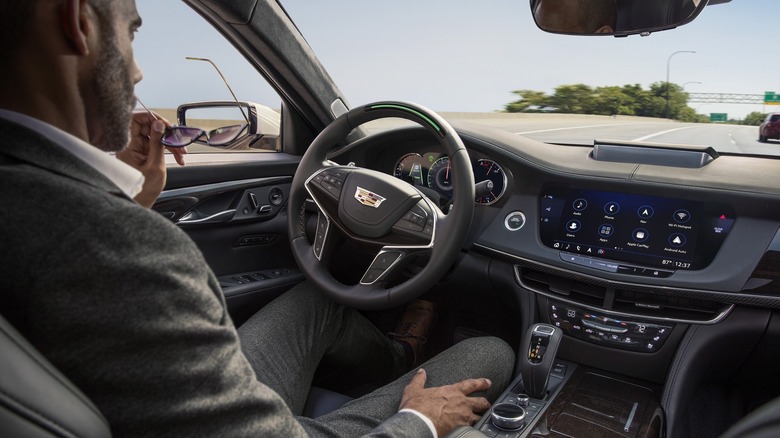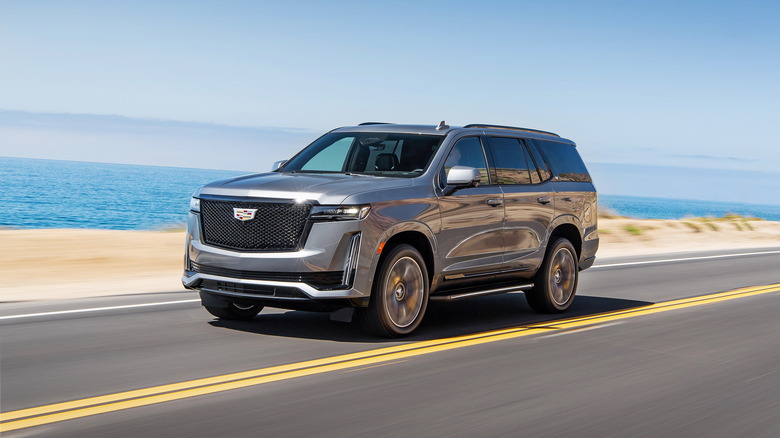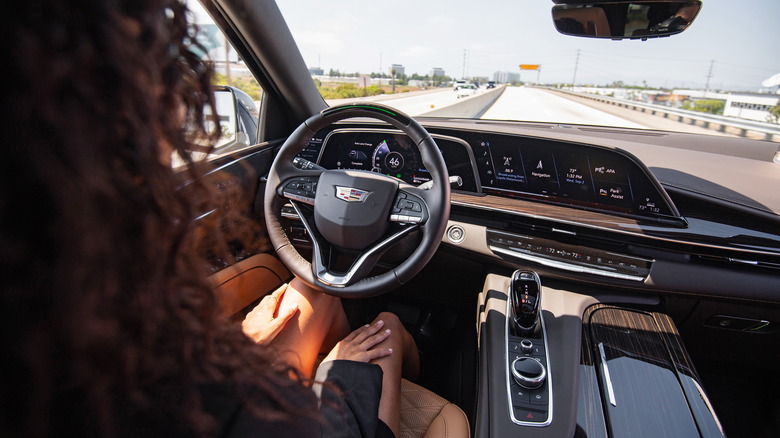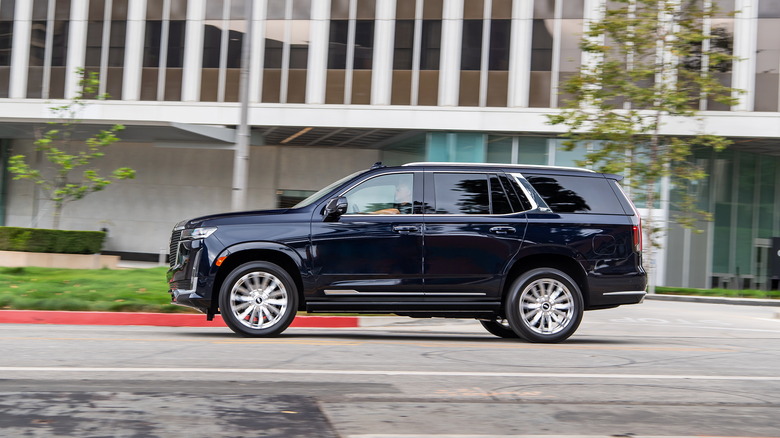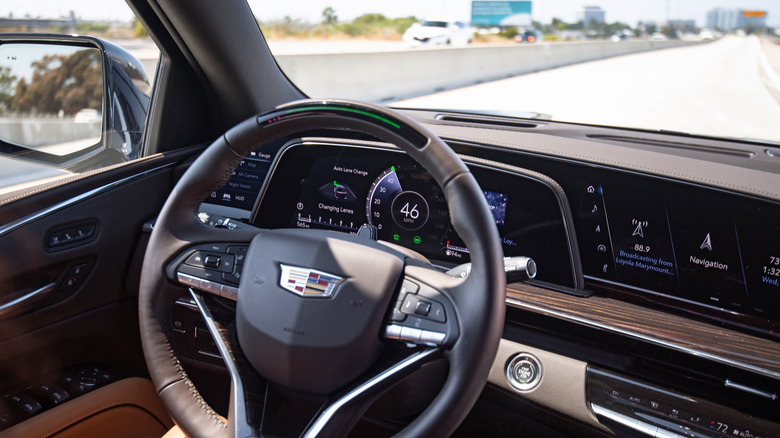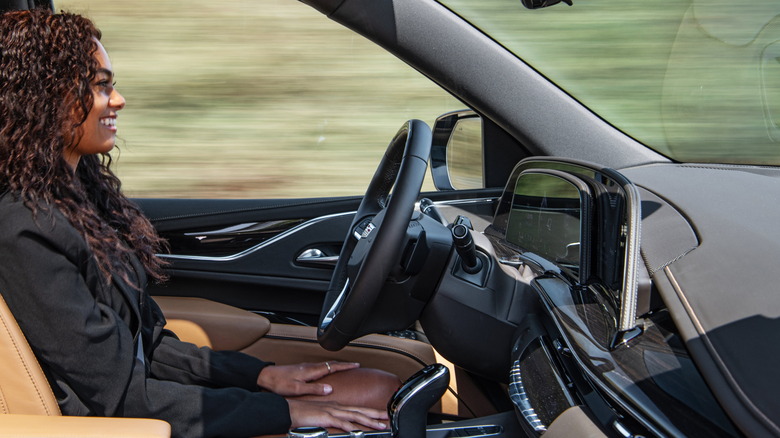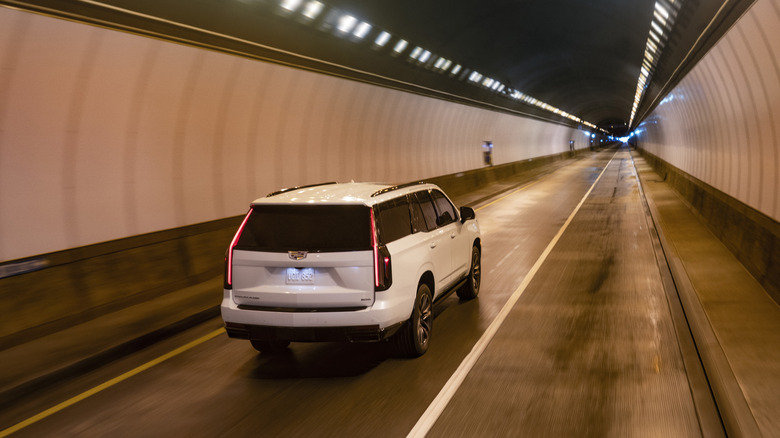GM's Super Cruise Is An Impressive Hands-Free Driver Assist, But It's Not For Everyone
The trend of more sophisticated driving assists has been a growing one in the automotive technology space for years, with many manufacturers taking different approaches to a burgeoning, if nebulous field. No doubt fast-tracked by the prominence of Tesla's Autopilot, automakers such as General Motors and Ford have been working on ways to incorporate a hands-free drive assist system in their respective vehicles in a safe way that puts drivers at ease.
For GM, this comes in the form of Super Cruise, a hands-free system that combines cameras, sensors and GPS data to allow its vehicles to drive themselves under driver supervision on major highways. Launched first in 2017, the latest version was included with the 2023 Cadillac Escalade I recently reviewed, and so decided to put it to the test, and the results were eye-opening.
How Super Cruise works
Super Cruise is an add-on feature for a select collection of 2018 to 2023 model-year Cadillacs, along with some GMC and Chevrolet models; some, but not all, are able to utilize the automatic lane-changing function included in the latest iteration of the system. On the Escalade it's a $2,500 option, though it's only available on the $91,095 Premium Luxury trim and above. At the car level, it uses multiple cameras to scan the areas ahead and behind the car, as well as to identify the lines of a highway lane. Sensors are employed to maintain distance from other vehicles while the car itself can accelerate, brake and steer enough to keep the Cadillac in the center of the lane.
A key part of Super Cruise is that it only works on major highways, and specifically ones that Cadillac has deemed compatible with the system. While initially this was a handful of major national highways, most highways are now compatible. As part of Cadillac's connected service, the system will use GPS data to determine if you're on a compatible highway. If not, or if you're just on a side street, only adaptive cruise control will engage. If you are, then the system receives LiDAR-scanned data of the highway you're on so the vehicle knows where each lane and bend is.
What's important to reiterate is that the driver is always in control and must be paying attention to what's going on, something that would make itself very evident during my time putting this system to use.
Cruise controls
The first opportunity to use Super Cruise was for an evening run to New York's JFK Airport. I knew that it would work down I-495, Long Island's major highway, but I was unsure about the comparatively smaller parkways I would also need to take.
Once fully merged on the highway, it was time to give it a go. To engage Super Cruise, the first step is to activate the adaptive cruise control as one normally would, setting the desired speed and locking it in with the "set" button. After that, a press of the Super Cruise steering wheel button starts a short but thorough activation process. First, as mentioned, it won't work if you're not on the highway, but once it passes that check, a steering-wheel mounted camera verifies the driver's looking ahead — or indeed there at all — while exterior cameras spot the road's lane lines and, if all is well, you're Super Cruising, baby.
Caddy take the wheel
From the beginning the car has communicated the system's status in two major ways. One is with a light strip that goes across the top of the steering wheel, and which changes color depending on conditions. When this is green, everything is nominal, but it will flash if it catches your attention wavering. Red flashes when it's time to take back control either to the conditions changing — it can't spot the lines in the road, for example — or if you depart from a compatible road. It also goes red when you've been really naughty about paying attention and fully ignore all the other alerts. Ignore these long enough and the car will suspect something is very wrong with you, slow to a full stop, and have an OnStar rep check to see if you're okay.
The other ways it communicates is through messages on the OLED digital gauge cluster, along with various beeps and vibrations from the haptic alert system built within the seat. These messages tell you when the system is on or not, and if not, why. It also alerts you when Super Cruise's latest feature, auto lane change, is engaging.
Defensive driving
Initially, all is going well, though I'm hesitant to fully relinquish control. My foot is half-cocked over the brake pedal and my hands are hovering over the steering wheel as if I'm in an awkward group photo. In a straight line, it feels like a normal, engaged adaptive cruise control that can operate at highway speeds: up to 85 mph, specifically. It leaves a reasonable gap between the car in front, but nothing too egregious, and will be quick to close it if another car passes through.
So far, so good, though it's when Super Cruise determines the lane over is moving faster is when things get freaky. While the system allows for automatic lane changes with input from the driver, the latest system also watches the passing lane for an opening. If you're traveling at under your set speed, and the lane adjacent is clear, the car will choose to hop over and speed things along on its own. This takes a little more getting used to, and it also isn't something that happens quickly, the Cadillac takes its time to do it as safely as possible, though this simple maneuver is enough to cause a mild bump in driver panic.
Free radicals
A few miles of this and with a change of byways, and the system's limitations make themselves clear. As compatible as Super Cruise may be for the highway, there's still the unpredictable nature of the other drivers out there. All the sensors and programming in the world could not prepare Super Cruise for the behavior of a Cross Island Parkway driver, something normal humans are barely able to cope with.
As it follows the car ahead, the system does a decent job of approximating the speeds human drivers stop and start, pleasantly stepping on the gas if it was forced to slow down drastically for a moment. What it won't do is predict the conditions ahead to compensate. Say the car ahead is leaving the highway, signaling that they're moving over. Super Cruise doesn't have the capacity to see this and speed up slightly to fill the spot. It instead can only wait until that car fully exits the lane before accelerating, and by then, someone else has usually seen the gap and has leapt in to fill it instead.
The automatic lane changing function also lacks that kind of nuance. The car is looking out for other vehicles in the adjacent lane both ahead and behind before moving over, though it's still not able to judge intent. Whenever it engaged, I would look nervously in the side mirror for another driver down the line making a similar move. When one would, I expected the car would see them ride up and abort, but it never did; I wasn't willing to play "chicken" just to see what would happen, and weighed in myself.
Invisible touch
Apart from when it disengages, there are other small scenarios that call for a human touch. For example, when it changes lanes, it –correctly — does so from the left, though it never moves over back to the right on its own after passing or if there is faster traffic behind. Unless the driver commands it to move over, it'll just camp in the left lane, oblivious. Maybe it's too human-like after all.
There are also moments when a highway has a fairly sharp bend, and while Super Cruise can judge the distance of the lane markers and turn accordingly thanks to the GPS data, it's never really clear how big of an angle is too big of one for it to react. Furthermore, it comes awfully close to the lane markers as well as other cars in the lane over doing the same, a feeling exacerbated in a vehicle the size of the Escalade.
On the way to the airport, I navigated there using Apple CarPlay mainly to judge my ETA through Google Maps. I wondered about the "approved highways" part of Super Cruise and wondered if it tied into the native navigation system at all, so I used that for the ride back home. Here, I was hoping that maybe, with a full journey mapped out, the car's behavior would be optimized the way EVs can plot optimal routes to charging stations. While I wasn't worried about range, I was hoping that maybe Super Cruise would maybe set me up in the correct lane as I merged or ended the highway portion of my drive, but nothing indicated it did so.
Cruising together
Having relinquished back control, I wondered who this system was for exactly. There is certainly a case for those who have hours-long drives across interstates either for work or vacation (Super Cruise can work in some cases while also towing), but I didn't see it as something I could get comfortable with through average highway commuting. For one, GM's system doesn't drive like me, and this will be true for anyone who uses it. Regardless of how safe or good of a driver you think you are, the subtle choices and habits that you have behind the wheel are different than the commands hard-wired into Super Cruise, and thus it will always feel off, even if it's performing in a safer way.
The other thing is, again, the unpredictability of other drivers. I see their choices defy logic on a daily basis and am constantly kept on my toes because of this, and until Super Cruise has some sort of adaptive AI learning this behavior, it's always going to be hard to "trust" it. Even then, I'd like to compare notes.
For me, it was a neat spectacle that I a momentary kick out of, but I never felt relaxed. It was quite the opposite, in fact, since I was almost always hovering over the controls and constantly keeping my head on a swivel like a driving school instructor with a new student at the helm.
To be fair, there were some positive takeaways. In the moments where traffic was thin enough for me to ease back a bit, it was admittedly cool to put my hands on my knees and pretend I was Professor X steering the Escalade with my mind. The following day, Super Cruise made the 14-mile drive into Manhattan more interesting, if not slightly easier to deal with, while it dealt with the stop-and-go traffic. As a paid feature — spreading not only through Cadillac's line-up but those of GMC and Chevrolet, too — it's something that really needs to be tried out before throwing it on the option list. It may be a huge assist for long drives or it may be a panic-inducing nightmare. Your mileage may vary.
